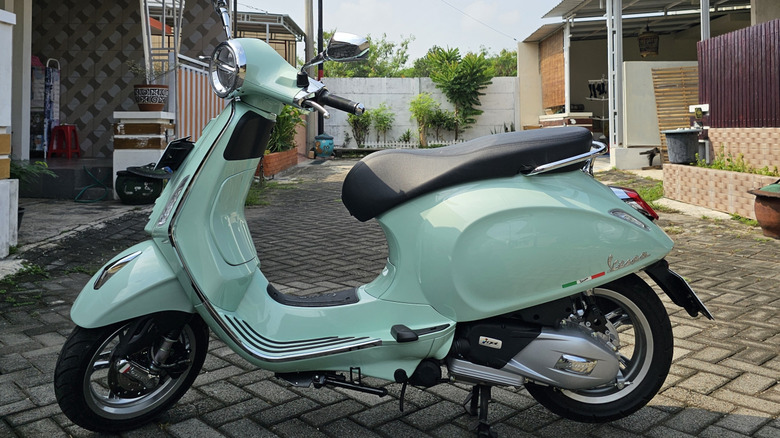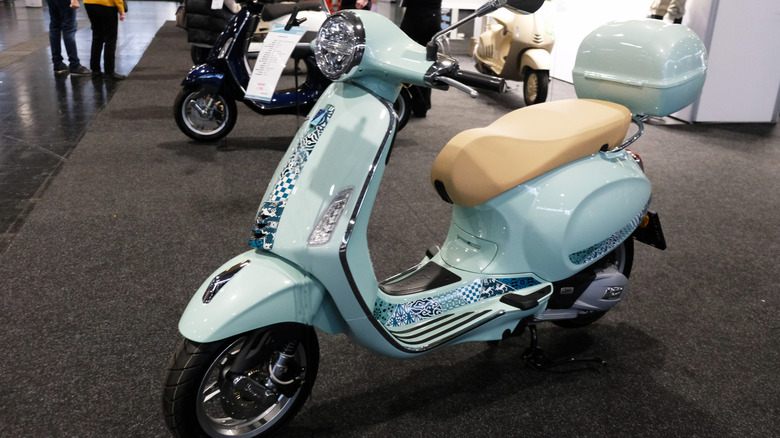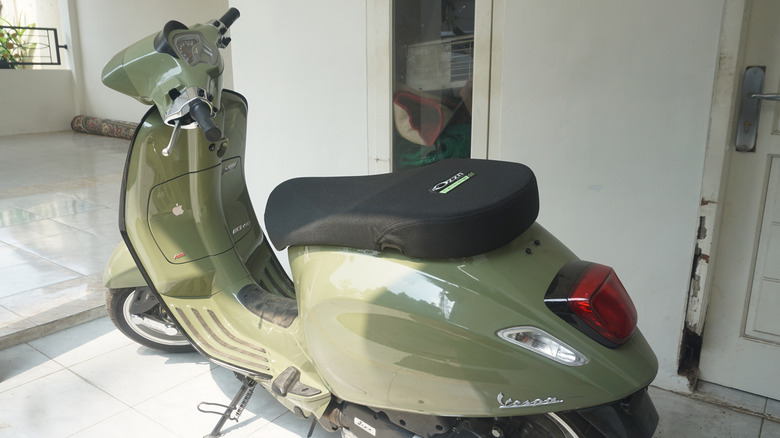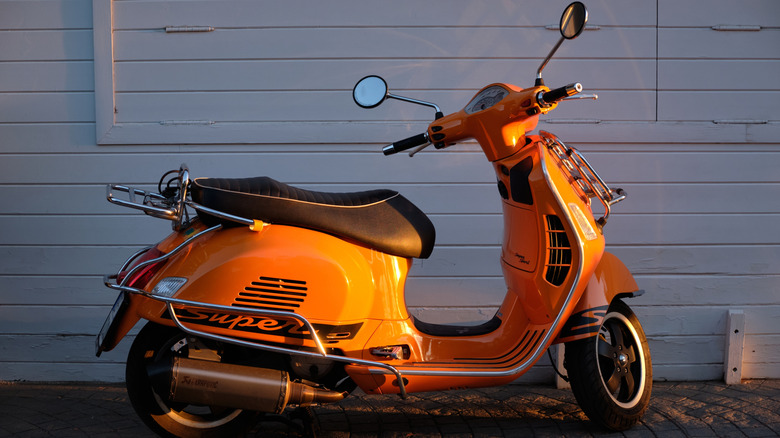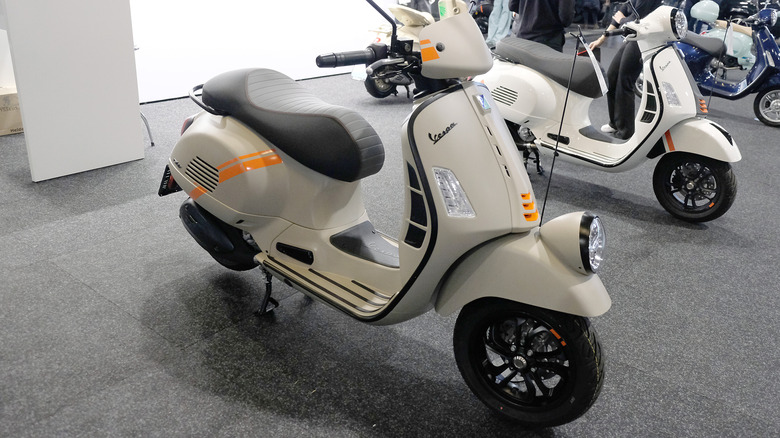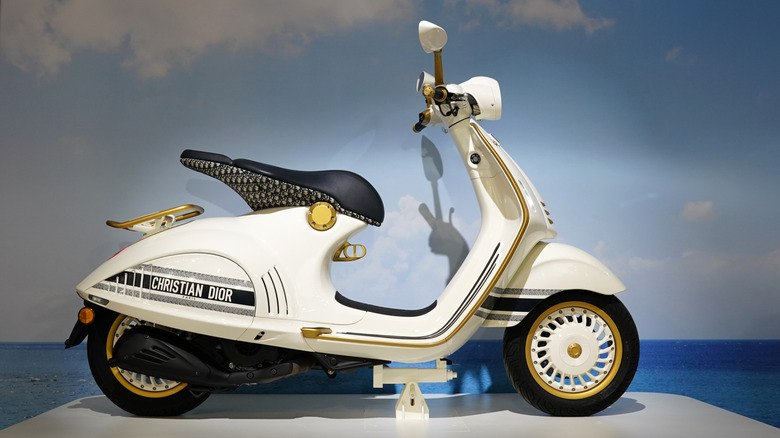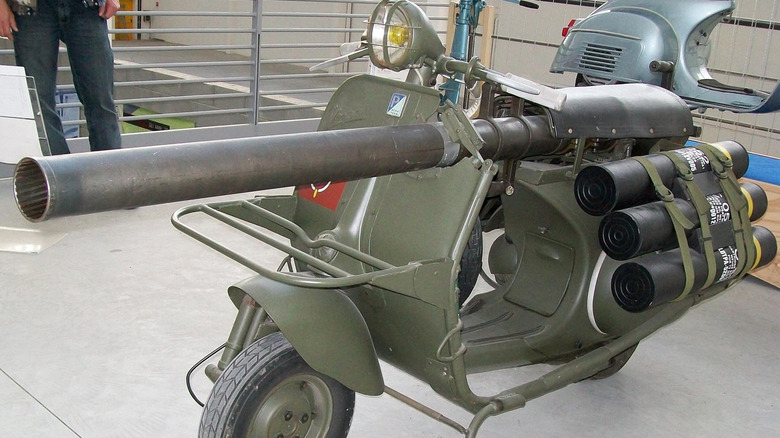How Fast Can Vespas Go? A Look At Each Scooter Model's Top Speed
Some things are beautifully, unmistakably Italian. The magnificent Roman ruins on display in the capital. The cuisine that continues to delight professional chefs and casual pasta enthusiasts around the world. The silky soccer skills of former Roma superstar Francesco Totti. Then, of course, there's the Vespa.
There aren't many brands that have the confidence to keep their auto design largely unchanged for the best part of a century, but sometimes you just get it right the first time. The Vespa company was founded in 1946, the year that the very first model, the Vespa 98, debuted. Ever since then, Vespa reports, the brand and its namesake scooter alike "has represented a zest for life and a desire to embrace the future." The trouble is, it's rather difficult to continue to embrace the future with an engine that's around 80 years old. It's lucky, then, that while the wasp-esque design of the vehicle has changed very little, the technology powering it has come a very long way.
The initial Vespa 98 model topped out at just over 37 mph, but surpassed this as its engine improved. Seven years later, the Vespa 125 was reaching over 46 mph. Today's models are a world away from these early efforts. Let's take a look at Vespa's latest lineup and the speeds each model can reach. Vespa currently lists six models in its range: the Primavera, Sprint S, GTS, GTS Super, GTV, and 946 Dragon. The crucial thing is that Vespa isn't forthcoming with official top speeds for its scooters — which are different machines to motorcycles – and so reviews, tests, and approximate values will be considered.
Vespa Primavera
The Primavera, our first case study, was first produced in 1967, and the idea was for the model to appeal to younger riders. To achieve this, the key was to blend power with an ease of handling and control and an affordability to make it a good beginner's model. As a result, the Primavera has never been, or intended to be, the fastest and most formidable Vespa around.
All of this is reflected in today's Primavera range, with a recommended retail price (RRP) ranging from $4,399 for the Primavera 50 to $8,299 for the Primavera Elettrica 70 RED. The former is a 50cc scooter, and as such, it's not going to be keeping pace with the fastest motorcycles ever built (except perhaps if they were being pushed instead of ridden). Nonetheless, it's quite zippy for a model of its caliber and an ideal entry level model to introduce newcomers to the waspy world of the Vespa.
What speed can riders expect to coax from it? Bike Social reviewed the 2013 Primavera 125, declaring its top speed to be 70 mph. Visor Down, reviewing the 125 in September 2024, seemed to concur, noting, "beyond 40mph things start to get a little labored and 50-60mph takes a long time. I did manage to nudge an indicated 70mph, but only with the assistance of gravity on a downhill stretch of dual carriageway."
Vespa Sprint S
Naturally, when considering the speed of a scooter, so much comes down to the engine size. It's all well and good to suggest a sense of speediness by adding "Sprint" to a model name, but the different models of the Sprint have rather different capacities.
The latest addition to the family is available in both Sprint 50 S and Sprint 150 S flavors, and as the price disparity suggests ($4,599 RRP for the former and $5,999 for the latter), there's a considerable difference between the two models. In 2022, Vespa Portland provided an in-depth guide to the Sprint 50, declaring that the model's maximum speed was "somewhere between 30 and 35 miles an hour on flat ground, depending on how long the road is and how much time you have to get there."
For a Vespa with a 50cc and below engine, Vespa Brooklyn reports that around 30 mph would be the top speed, which ties in with the previous dealer's analysis. The Sprint 150, meanwhile, has a far larger engine, and so its performance would be expected to be considerably loftier. Reviewing the 2024 Sprint 150 S, Vespa Motorsport concluded, "these scooters are good for about 65, maybe 70 miles per hour." This is around the same pace of the Vespa Primavera 125, indicating that models in the 125-150cc engine range are capable of hitting these sorts of marks. One model with an even larger engine still effortlessly tops these numbers. Let's meet it.
Vespa GTS And GTS Super
Whenever an auto manufacturer adds a suffix like "Super" to the name of a new model, there's a pressure to deliver something that stands as a significant upgrade. In this case, then, it's a safe bet that the GTS Super will be more powerful and faster.
The GTS 310 is declared by the EICMA to be "the most powerful, snappy and fast Vespa ever made." This, it seems, is no exaggeration. In November 2024, a Cycle World first look at the '25 model stated that it was capable of speeds up to and beyond 80 mph. For a model of its kind, this is a considerable pace indeed, and more than twice as fast as the original Vespa that arrived all those years ago. Who'd ever have believed that 25 horsepower could carry a Vespa so far?
Even more importantly than that, though, its relatively formidable 310cc engine wasn't included at the expense of practicality and drivability. On the contrary, the outlet went on, it was designed to focus on those very aspects, with more comfortable seating and a retooled engine for a smoother ride among the improvements between the GTS Super and GTS SuperSport. More power doesn't necessarily mean a ride that's harder to tame, or one that compromises on the usability that Vespa has become known for.
The GTS 300 Super Sport reached 78 mph in a 2023 Bike Matters road test, cementing it as one of the very speediest Vespas around.
Vespa GTV
The important thing to address is the difference between the GTV and the GTS. After all, just as with the GMC SLE and SLT, we're just a single-letter typo away from complete confusion. It's especially important for potential buyers because there's a notable difference in price between the GTS, GTS Super, and GTV. The GTS 300 has an RRP of $7,899 compared to $8,199 for the top of the range GTS, the 310 SuperSport, and $8,499 for the GTV 300.
The GTV, in short, is a sportier, stylish variant of the same model. This model family has had a bit of a speedster reputation since its first years on the market, with Auto Evolution noting that Vespa claimed that the GTV 250 that began production in the 2009 model year could top out at 76 mph. What has almost two decades of further GTV refinement meant for the family?
The GTV 300 in particular has been seen in many different guises, including the rather magnificent GTV 300ie Vie della Moda, introduced in all its exclusive brown finery in 2012. By 2011, the GTV 300 offered a top speed of 80 mph. This is still around the benchmark for the GTS and GTV family, with Vespa Motorsport noting of four models of the '24 GTS and GTV 300 range, "top speed on all of these scooters is just shy of about 80 miles an hour."
946 Dragon
The final member of the Vespa model family currently listed by the manufacturer is the rather intimidating-sounding 946 Dragon. This is the costliest of the models that Vespa currently offers, weighing in at a formidable $13,499. Sadly, you won't catch this dragon breathing fire or menacingly brandishing its spiny tail at Harry Potter, and perhaps even worse, it doesn't have the brand's most potent engine. No, it isn't the fastest Vespa on the block, but it certainly makes a strong argument for the crown of the best-looking.
Vespa is a brand that found its aesthetic a long, long time ago and hasn't particularly deviated from it ever since. Even in such cases, though, branching out from time to time is healthy for us all, and the 946 Dragon represents a bold step out of that comfort zone. The 946 family (pictured here in a different exclusive guise) was established in 2013, and this unique design series was focused on the notion of the Lunar New Year. Just as each year corresponds to a different animal, so does each model year of the 946. 2023 was the year of the 946 Rabbit, the '24 model year introduced the Dragon, and 2025's 946 is the Snake.
The Dragon was built in limited quantities of 1888, equipped with a 125cc single cylinder air-cooled engine. HT Auto states that the model has a top speed of approximately 56 mph, putting it at the lower end of the scale among its fellow Vespas.
Vespa 150 TAP
Regardless of the speed a specific Vespa model may be able to attain, there's no denying that, overall, they're typically considered friendly, urban, flat-road scooters, preferred for their ease of use and sensible, economical use of fuel. None of this remotely screams "military vehicle," but the Vespa 150 TAP is a fascinating case to consider in the realm of Vespa performance.
Ateliers de Construction de Motocycles et Automobiles introduced this utterly unique Vespa in 1956. Far from being designed to trundle between fashionable cafes in Paris, it was created for the Troupes AéroPortées, the French military's elite paratroopers. By their very nature, these units require gear that's easily transportable, lightweight, and practical wherever it possibly can be, and that appears to have been the logic that went into the heaviest-armed (that is, the only armed) Vespa ever.
The TAP featured a forward-facing M20 gun, which, for the uninitiated, isn't a simple machine gun. Believe it or not, this Vespa was part transportation and part deadly weapon. The M20 was a valuable weapon capable of destroying tanks. Popular Mechanics dubbed it "a modern version of a pack mule that could be dumped out of the back of a cargo aircraft behind enemy lines," noting that it was a reinforced model that boasted as much storage space as a Vespa could muster to help it in this aim. A mule it may have been, but it was still capable of topping 40 mph on a 145cc engine.
